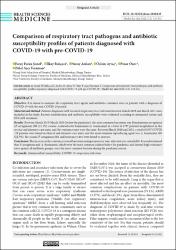Comparison of respiratory tract pathogens and antibiotic susceptibility profiles of patients diagnosed with COVID-19 with pre-COVID-19
Citation
Şenol, F.F., Bahçeci, İ., Arslan, N., Aytaç, Ö., Öner, P. & Aşçı Toraman, Z. (2022). Comparison of respiratory tract pathogens and antibiotic susceptibility profiles of patients diagnosed with COVID-19 with pre-COVID-19. Journal of Health Sciences and Medicine, 5(2), 510-516. https://doi.org/10.32322/jhsm.1010249Abstract
Objective: It is aimed to compare the respiratory tract agents and antibiotic resistance rates in patients with a diagnosis of
COVID-19 with the non-COVID-19 period.
Material and Method: Patients diagnosed with bacterial respiratory tract infection between March 2019 and March 2021 were
included in the study. Bacteria identification and antibiotic susceptibility were evaluated according to automated system and
EUCAST standards.
Results: Between March 2019-March 2020 (before the pandemic), the most common bacterium was Pseudomonas aeruginosa
(P. aeruginosa) 280 (15.5%) second Acinetobacter baumannii (A. baumannii) in a total of 1797 patients hospitalized in the
service and intensive care units, and the resistance rates were the same. Between March 2020 and 2021, a total of 1357 COVID
-19 patients were found in clinical and intensive care units, and the most common reproducing agent was A. baumannii 168
(12.3%), the second P. aeruginosa 164, and resistance rates were found to invrease.
Conclusion: The increase in the resistance rates of bacteria causing respiratory tract infection was remarkable. It was determined
that P. aeruginosa and A. baumannii, which were the most common isolates before the pandemic and showed high resistance
rates against all antibiotic groups, were the most common bacteria during the pandemic period.


















